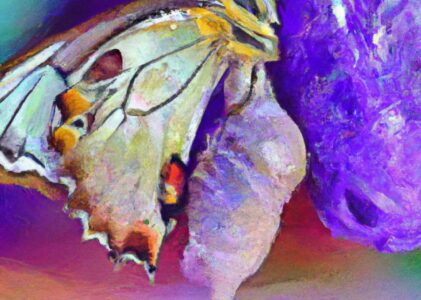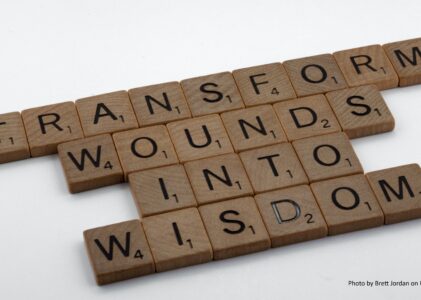When someone starts talking about transformation and healing, I immediately think of the brain, the mind. Through my research I have found that most people think about a significant and positive change or evolution in various aspects of their life. This can include personal growth, self-improvement, inner healing, or a dramatic shift in mindset, behavior, or circumstances.
I have learned over the years that transformation is not just about the mind. The mind and body are connected. What one believes in their mind affects their body. There is an intricate relationship between our thoughts, emotions, beliefs, and our physical health. The mind-body connection suggests that our mental and emotional states influence our physical well-being, and vice versa.
The mind-body connection is rooted in the biological and neurological systems of the body. The brain and nervous system play a central role in processing and responding to both internal and external stimuli, including thoughts, emotions, and sensations. Neurotransmitters, hormones, and other chemical messengers transmit signals between the brain and the body, influencing various physiological processes.
Our thoughts, emotions, and beliefs have a direct impact on our physical responses. For example, when we experience stress or anxiety, the brain activates the body’s stress response system, triggering the release of stress hormones such as cortisol and adrenaline. These hormones can lead to physical changes such as increased heart rate, elevated blood pressure, and muscle tension.
It is my belief that you cannot transform the mind only. In the process of transforming your mind you will transform your body. In the process of transforming your body you will transform your mind.
Please don’t misunderstand me. You aren’t going to have the body of an athlete if you simply change your mindset. However, if you have a mindset shift and believe you can have the body of an athlete you can actually achieve that. It will take work and perseverance. But if you believe you can, you will. Henry Ford said, “Whether you think you can or think you can’t, you’re right.”
I would rather practice wellness than always addressing sickness. Wellness includes many healing modalities that encompass a wide range of practices and techniques to support the journey of transformation. My purpose in this article is to introduce different methods and for you to choose the ones that fit your beliefs, lifestyle, and pocketbook.
Traditional Therapy
Traditional therapy or counseling sessions with licensed therapists provide safe and supportive environments for you to explore your thoughts, emotions, and experiences. Therapists utilize various therapeutic approaches such as cognitive-behavioral therapy (CBT), dialectical behavior therapy (DBT), psychodynamic therapy, solution focused brief therapy, (SFBT) and trauma-informed therapy to help individuals process their past traumas, develop coping strategies, and cultivate resilience.
I have engaged in psychodynamic therapy, solution focused brief therapy and trauma-informed therapy. My favorite, by far, was the solution focused brief therapy. I found it to be the quickest and most effective therapy with the best results. I found that dwelling on the past and it’s influence on my life was a slow painful process as I had to relive the events and the emotions. I got more and more depressed and felt like I was spinning my wheels getting nowhere.
Sure, I did get some helpful tools in the process but the road was painful and too long.
With solution focused brief therapy I determined the outcome I wanted and mapped out the road to get there. I didn’t dwell on the past. I focused on my now and my future. Less money. Better results.
Mindfulness and Meditation
Mindfulness and meditation practices are powerful tools for cultivating self-awareness, reducing stress, and promoting emotional well-being. These practices involve paying attention to the present moment with openness and acceptance, without judgment. Techniques such as mindful breathing, body scans, and loving-kindness meditation can help individuals become more grounded, centered, and connected to themselves.
Meditation and mindfulness take time and practice. One often hears that you need to “empty your mind” to be an expert meditator and look like the gurus in many pictures. I have found that it is impossible to silence the chatter in my mind.
I started meditation and mindfulness about 3 years ago. It was tough at first. As soon as I sat in a quiet space my mind took over. I made grocery lists, listed phone calls I needed to make, jobs I had to do and even try to figure out solutions to not only my own problems but other people’s problems too. I was so frustrated I almost gave up.
Then, I read something by Dr. Wayne Dyer. He stated that it was not possible to empty your mind. He did say that it was possible to acknowledge the thoughts and let them pass. He said not to make judgements on what my mind was doing, just let the thought pass. I tried it and it works.
Now, I practice meditation at least twice a day, especially in the morning. I have joined a group of other meditators. We are currently working our way through the chakras. I am loving this practice.
The other meditation I do is online with Dr. Joe Dispenza. I find that my days are easier because I have more trust. More trust in myself. More trust in God. More trust in my abilities and the people who come into my life.
Mindfulness to me is paying attention to my thoughts and my words. How am I speaking to myself? How am I speaking to others? Am I being loving and kind? Am I being compassionate? When I pay attention, I can see what I like and don’t like and can change it in an instant.
I find driving brings out the worst in me. When I’m mindful I realize that the person who just pulled that jerk move has their “stuff” to go through and I can let it go and continue on my way without stewing or swearing about it.
Yoga
Yoga combines physical postures, breathwork, and meditation to promote holistic health and well-being. Yoga helps individuals release tension stored in the body, increase flexibility and strength, and cultivate mindfulness.
The practice of yoga increases body awareness. Through the practice we learn how we move through life. With breathwork we become aware of the importance of oxygen not only our physical body but to our emotions as well.
I used to hate yoga. I took many classes wanting to like it. But I never did! I walked out of a yoga class feeling like I got nothing out of it. The only yoga pose I really liked was “legs up the wall”. Yummy but not worth doing a whole class.
Then Covid hit. I wasn’t exercising as much. I was going through cancer treatments with my mom and a divorce. My stress levels were very high. All I wanted was to stretch. The only way I knew to get the stretch I desired was through yoga.
I contacted my sisters and told them my dilemma. I asked them to join me in an online yoga class. They all agreed. We would do the yoga practice in our own homes and text the others when we were done and report on how we did. This was the beginning of my love of yoga. I do not do it everyday but I do engage in the practice at some point during the week. I also use some yoga moves as a cool down to my regular workout. Now, yoga is yummy and worth it to me.
Art Therapy
Art therapy is a form of expressive therapy that uses the creative process of making art to improve and enhance physical, mental, and emotional well-being. It can be a powerful tool for self-expression, exploration, and healing.
Through various art forms such as painting, drawing, sculpture, and collage, you can externalize your internal experiences, gain insights into your emotions, and access deeper layers of your consciousness. Art therapy can be particularly beneficial for those who may find it challenging to verbalize their feelings or simply don’t have the words to express themselves.
Many therapists, counselors, and mental health professionals offer art therapy sessions as part of their practice. These sessions provide a safe and supportive environment for individuals to explore their thoughts, feelings, and experiences through artmaking. If you would like to experiment with art therapy, ask your therapist about it. If they don’t offer it as part of their practice, they should be able to connect you with someone who does.
Community art centers often offer classes, workshops, and open studio sessions for people of all ages and skill levels. These centers provide access to art materials, studio space, and guidance from experienced instructors, making it easy for individuals to explore their creativity in a supportive and non-judgmental setting.
There are many online resources and platforms that offer virtual art classes, tutorials, and communities for artists of all levels. Websites such as Skillshare, Udemy, and YouTube provide a wealth of instructional videos and resources for learning different art techniques and styles from the comfort of home.
Attending local art events, exhibitions, and gallery openings can also inspire artistic expression. These events provide opportunities to connect with other artists, explore different art forms and styles, and gain inspiration from the work of others. It also gets you out of the house. Call up a friend or go by yourself. You will never regret feeding your mind with soulful adventures.
Art therapy is more about the process of creating than the end result. Maybe we should rename art therapy, Creative Healing. Hmmmm, I like that sound of that.
Focus on the act of self-expression and exploration rather than worrying about creating a masterpiece. Experiment with different art mediums and techniques to find what resonates with you. Painting, drawing, sculpture, or mixed media. Pick one to start. There are endless possibilities for creative expression.
There are no right or wrong ways to make art. Your efforts and your unique perspective and experiences are valuable. If you are perfectionist Creative Healing is an ideal way to climb out of the perfection space and accept what is and call it beautiful. Always remember, the more you engage in the activity the better you get.
Nature Therapy
Spending time in nature has been shown to have numerous therapeutic benefits, including reducing stress, improving mood, and promoting overall well-being. Nature therapy, also known as ecotherapy or wilderness therapy, includes activities such as hiking, gardening, or simply spending time outdoors in natural settings. Forest bathing or Shin Rin Yoku is a method of nature therapy. Get out in the bush or the woods. Don’t be afraid to touch the trees.
Connecting with the natural world can help you feel grounded, rejuvenated, and connected to something greater than yourself. Stop. Breathe. Relax. Believe. Love.
Breathwork
Breathwork practice focus on the conscious control of your breath to promote relaxation, emotional release, and inner healing. Techniques such as deep diaphragmatic breathing, breath awareness, and breath retention can help you regulate your nervous system, reduce anxiety, and access deeper states of consciousness. Breathwork sessions led by trained facilitators provide a supportive space for individuals to explore their breath and its connection to their emotions and experiences.
I started doing breathwork when I was introduced to the work of Wim Hof. Wim Hoff, also known as The Iceman, is a Dutch motivational speaker and extreme athlete noted for his ability to withstand low temperatures. His method is a technique that combines controlled deep breathing, cold therapy, and commitment to help you connect more deeply to your body.
I enjoy the Wim Hoff breathwork. I have not mastered the cold therapy. I keep trying but I have to admit I do not like it. I would rather be warm. There is still a benefit to engaging with his breathing technique.
I have discovered other breathing techniques through my yoga practice and with my meditation coach SevaRam Spronk. I love all of it.
Pure Bioenergy Healing Therapy
My favorite healing modality is Pure Bioenergy Healing Therapy. Pure Bioenergy Healing Therapy is based on the principle that the body has an innate ability to heal itself when its energy flow is balanced and unobstructed.
Pure Bioenergy Healing Therapy offers a gentle yet powerful approach to promoting health and well-being by restoring the body’s natural energy balance. It can be an effective tool for addressing a wide range of physical, emotional, and mental health concerns and supporting individuals on their journey toward optimal wellness.
Practitioners of Pure Bioenergy Healing Therapy work with the body’s energy allowing energy to flow freely and facilitate the healing process.
Pure Bioenergy Healing Therapy utilizes various techniques to assess and address energetic imbalances in the body. These techniques may include identifying areas of congestion or depletion, and using specific hand movements and intention to channel healing energy to the affected areas. The energy of life has all the information of wellness in it, therefore the body knows exactly what to do with it. The therapy is non-invasive, structured and typically involves light touch or hands-off approaches.
Pure Bioenergy Healing Therapy can be used to address a wide range of physical, emotional, and mental health concerns. It is often used to alleviate pain, accelerate healing from injuries or surgeries, reduce stress and anxiety, improve sleep quality, and enhance overall well-being. The therapy is gentle and suitable for people of all ages, from infants to the elderly.
Clients who receive Pure Bioenergy Healing Therapy often report feeling deeply relaxed, peaceful, and energized during and after sessions. Some may experience sensations such as warmth, tingling, or subtle movements in the body as energy begins to shift and rebalance. Many clients notice improvements in their symptoms and overall well-being with continued sessions over time.
Pure Bioenergy Healing Therapy can be used as a complementary approach alongside conventional medical treatments. While it is not a replacement for medical care, it can support the body’s natural healing processes and enhance the effectiveness of other treatments.
Each month you get to participate in an online Pure Bioenergy 4 Life Healing Event. You can register using this link. For more information about this healing modality click on any of the links above.
You will notice that I did not talk about diet and exercise. There is so much information available to you if you want to go in this direction. I felt it was better to talk about other ways to transform your body. Choose one of the modalities I’ve talked about. Experience the difference it can make in your life. I dare you!




